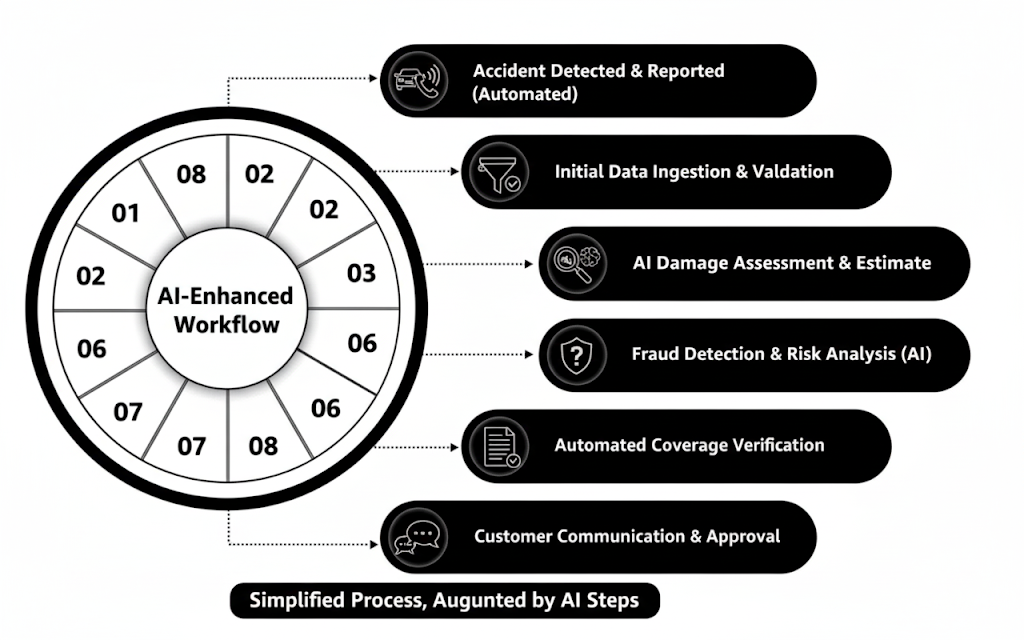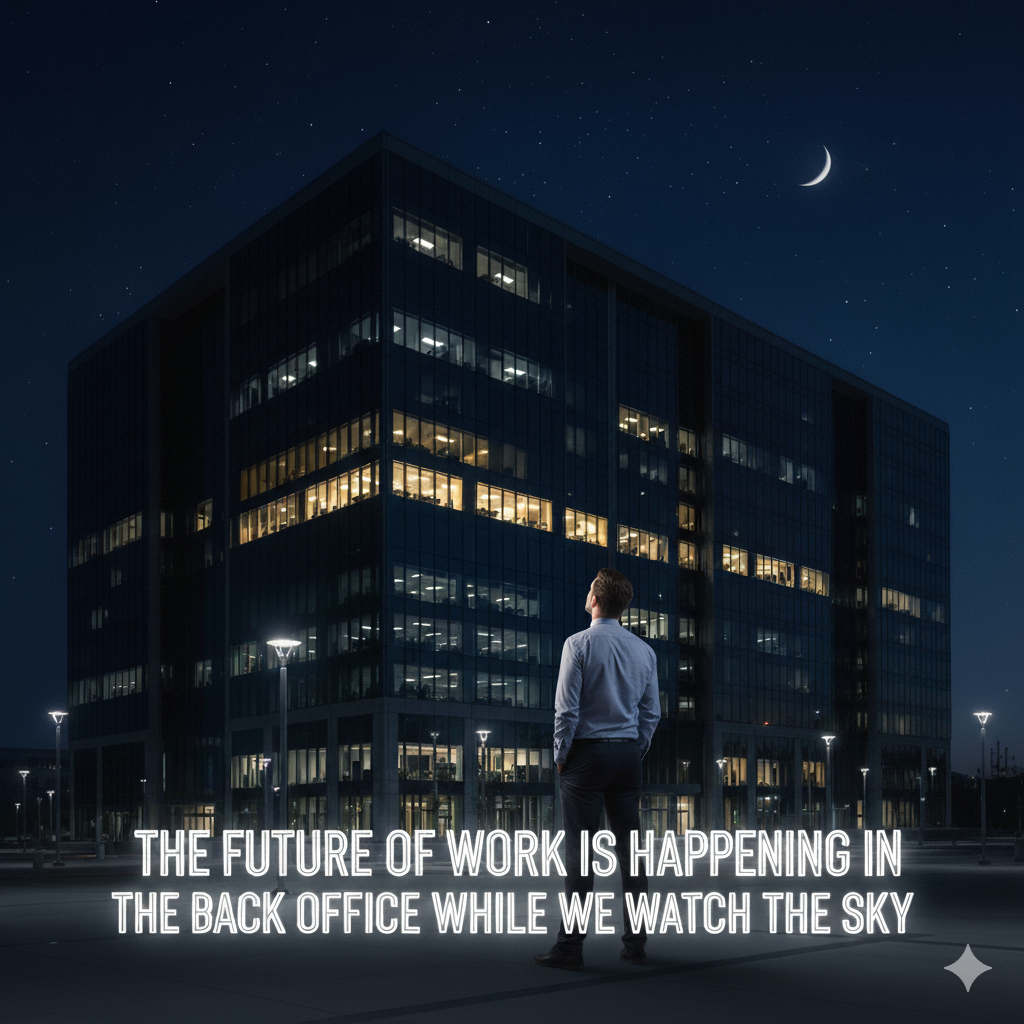The Real AI Threat: Why Businesses Are Getting Dumber (and Richer)
Everyone is looking at the sky. We’re all craning our necks, waiting for the arrival of the big one: Artificial Superintelligence. We read the breathless articles, we watch the TED talks, and we debate when the machine will finally wake up and become smarter than all of us combined. It’s the blockbuster movie version of the future, complete with a dramatic, world-altering climax.
It’s also a complete head fake.
The real threat to the way we work isn’t some god-like ASI descending from the heavens. It’s a much quieter, more boring, and far more immediate revolution. The future isn’t about AI getting smarter than us. It’s about businesses realizing they can get dumber and make more money.

Two Futures (And Why You’re Worried About the Wrong One)
Let’s break it down. Imagine two possible futures for AI.
Scenario 1 (The Boring Future): AI hits a ceiling. It gets very good at specific things, but never really achieves the flexible, general intelligence of a human. It plateaus as a “good enough” tool, but not a true replacement for a thinking person. Scenario 2 (The Sci-Fi Future): AI keeps getting smarter, eventually blasting past human intelligence. Jobs get vaporized, the world changes, roll credits. This is the scenario that occupies 99% of the conversation.
You’d think we’re safe in Scenario 1. We’re still the smartest ones on the block, right? Our jobs, with all their nuance and complexity, are secure.
That’s a dangerous mistake. It completely ignores the most ruthless rule in business:
Being dumb and profitable is always better than being smart and losing money.
We assume that to replace a smart human doing a smart job, you need a smart AI. You don’t. All you need to do is take that one smart, expensive job and break it into ten cheap, dumb processes. Then you hand those ten dumb processes to a “good enough” AI.
And here’s the kicker: this isn’t some distant prediction. It’s already happening. The World Economic Forum’s 2025 Future of Jobs Report dropped a bombshell that barely made headlines: 40% of employers expect to reduce their workforce where AI can automate tasks. Not someday. Now.

The Death by a Thousand Cuts: Real-World Examples
Let’s look at how this plays out in the real world.
The Insurance Adjuster
A seasoned human adjuster investigates a complex claim—say, water damage from a freak storm. They use their experience to interpret the policy, assess the unique circumstances, spot potential fraud, and negotiate a fair settlement. It’s a smart, nuanced process. An AI today can’t do that.
But a company can dismantle that job. The new process looks like this:
- Homeowner uploads photos to an app.
- An AI scans the images using computer vision to identify damage patterns like “mold” or “pipe burst.” (Dumb Process)
- Another AI scans the policy document for coverage related to those identified issues. (Dumb Process)
- If the damage doesn’t match a pre-approved template, the claim is flagged for minimal payout or auto-denial. (Dumb Process)
- The homeowner is directed to a chatbot if they want to appeal. (Dumb Process)
The company’s process has become profoundly dumber. It has lost all nuance. But it has also fired its entire team of experienced, expensive adjusters. It is now wildly profitable.
Is this really happening? Yes. UK insurance giant Aviva rolled out over 80 AI models in 2024, cutting liability assessment time for complex cases by 23 days and saving more than £60 million ($82 million). They improved routing accuracy by 30% and reduced customer complaints by 65%. The difference between my dystopian example and reality? Aviva kept humans in the loop for edge cases. But notice the trend: fewer adjusters, handling only the weirdest scenarios, while AI processes the other 80%.

The Corporate Buyer
A skilled procurement officer builds relationships with suppliers. They negotiate long-term deals, anticipate supply chain disruptions, and make strategic choices that aren’t just about the lowest price today.
The “good enough” AI replacement:
- An algorithm scrapes supplier websites and APIs for the lowest unit price on a given item. (Dumb Process)
- It auto-generates a purchase order to the cheapest vendor. (Dumb Process)
- If the cheapest vendor is out of stock, it simply moves to the next cheapest, regardless of quality or shipping time. (Dumb Process)
The smart, relationship-based part of the job is gone. The company is now vulnerable to supply chain shocks and is likely buying inferior products. But the payroll for the procurement department has vanished. The quarterly report looks fantastic.
Until the supply chain collapses. But that’s next quarter’s problem.
The Secret Blueprint: Your CPU is Obsolete
This isn’t just a business theory; it’s the foundational principle of the very technology we’re talking about. Think about how modern computing works.
For decades, we chased “smarter” processors (CPUs). A CPU is like a genius mathematician—it has a few incredibly powerful cores that can solve complex, sequential problems one by one, using general-purpose processing to handle any task you throw at it.
But the AI revolution wasn’t built on CPUs. It was built on GPUs.

A GPU is the opposite of a genius. It’s an army of thousands of smaller, simpler cores designed for parallel processing. Not one of these cores can solve a complex problem on its own. But they can all perform the same dead-simple calculation (like matrix multiplication) at the exact same time. By throwing a massive, complex problem at this army and breaking it down into millions of tiny, dumb pieces, the GPU achieves a result that the “smarter” CPU never could, and at a fraction of the cost and energy.
This is the blueprint for the new economy. We’re not waiting for a single, genius AI to replace a human. We’re building a corporate GPU, taking the complex work of a single, expensive human and breaking it into a thousand dumb, parallel tasks that can be executed by a swarm of “good enough” AIs. It’s less elegant, but it’s brutally effective and overwhelmingly profitable.
The Numbers Don’t Lie
McKinsey’s 2024 research found that the average worker has about an hour of daily activities with technical potential to be automated right now. By 2030? Three hours per day. That’s not replacing your entire job—that’s carving it into pieces and automating the chunks that can be parallelized.
MIT researchers project that AI will replace 2 million manufacturing workers by 2025. Customer service? 80% automation potential. These aren’t far-off predictions—we’re already in 2025, and these workers are already being let go.
Why “Good Enough” Beats “Perfect”
Now, I need to add some nuance here, because the real story is messier than my stark examples suggest.
Modern AI isn’t quite as “dumb” as I’m making it sound. Today’s systems use computer vision that can actually identify damage patterns, natural language processing that understands context, and pattern recognition that handles some nuance. When I say “dumb processes,” I mean narrow but capable AI—systems that are brilliant at one specific thing but useless at everything else.
And most companies aren’t going full scorched-earth on their workforce. The pattern we’re seeing is hybrid automation: humans handle the weird edge cases, AI processes the other 80-90%. Aviva didn’t fire all their adjusters; they just need far fewer of them.
The Question That Should Keep You Up at Night
So while the philosophers and futurists debate the consciousness of a hypothetical ASI, the real revolution is already happening in the back offices of insurance companies, logistics firms, and corporate finance departments. They aren’t waiting for AI to get smarter. They’re busy redesigning their companies to be dumber.

The regulatory landscape might slow this down. Auto-denying insurance claims based on keyword matching would face scrutiny in most markets. Reputation matters. Customer experience matters. But the economic incentive is overwhelming, and companies are testing the boundaries of what they can get away with.
The question isn’t whether AI will one day be smart enough to take your job.
The question is whether your boss will realize they can make more money by breaking your job into pieces dumb enough for today’s AI to handle.
And if the numbers are any indication, they’re already doing the math.
Sources
- World Economic Forum, Future of Jobs Report 2025
- McKinsey & Company, AI Automation Research 2024
- MIT Economic Research, Manufacturing Automation Projections
- Aviva Insurance, AI Implementation Results 2024 (£60M savings, 23-day reduction in assessment time)
- Various industry reports on CPU vs GPU architecture in AI applications